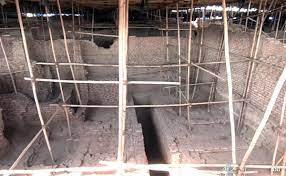
Evidence of 2,800-Year-Old Settlement Found In Vadnagar
Evidence of 2,800-Year-Old Settlement Found In Vadnagar
GS-1: Art and Culture
(UPSC/State PSC)
Important for Prelims
Recent Key Findings, Vadnagar-Historical significance, Dark Age, Archeological Survey of India.
Important for Mains
About Vadnagar, Vadnagar-Historical significance, Conclusion.
Jan. 18, 2024
Why in News:
Recently, a joint study by the Indian Institute of Technology (Kharagpur) has discovered evidence of cultural continuity in Vadnagar indicating the likelihood of the concept of a “Dark Age” being a myth.
- Reflecting its historical significance, the settlement has emerged as the oldest surviving city of India with a rich cultural continuity dating back to 800 BC.
Key Findings:
Cultural Continuity:
- The excavation at Vadnagar uncovered evidence of a human settlement dating back to 800 BCE, during the late-Vedic/pre-Buddhist Mahajanapadas or oligarchic republics.
- This suggests a remarkable cultural continuity in Vadnagar, challenging the notion of a "Dark Age" in Indian history.
Influence of Climate Changes:
- The study indicates that the rise and fall of different kingdoms over a 3,000-year period, as well as recurrent invasions by Central Asian warriors, were influenced by severe changes in climate such as rainfall or droughts.
- This highlights the interconnectedness of environmental factors with historical events.
Multicultural and Multireligious Settlement:
- Vadnagar is described as a multicultural and multireligious settlement, with evidence of Buddhist, Hindu, Jain, and Islamic influences.
- The excavation revealed seven cultural stages, representing different historical periods, including Mauryan, Indo-Greek, Indo-Scythian, Hindu-Solankis, Sultanate-Mughal, and Gaekwad-British colonial rule.
Archaeological Artefacts:
- The excavation unearthed a variety of archaeological artefacts, including potteries, copper, gold, silver, iron objects, intricately designed bangles, and coin moulds of the Greek king Appollodatus from the Indo-Greek rule period.
Oldest Living City:
- Vadnagar is identified as the oldest living city within a single fortification found in India so far.
- Unpublished radiocarbon dates suggest that the settlement could be as old as 1400 BCE, challenging the traditional understanding of the Dark Age in Indian history.
Significance:
- This evidence makes Vadnagar the oldest living city within a single fortification unearthed so far in India.
- Some of the recent unpublished radiocarbon dates suggest that the settlement could be as old as 1400 BCE contemporary to the late phase of the post-urban Harappan period.
- If this is true, then it suggests a cultural continuity in India for the last 5500 years and the so-called Dark Age may be a myth.
About Vadnagar:
- Location: Vadnagar is a city and municipality under Mehsana district in the North Gujarat region of Gujarat state.
- Vadnagar is situated in the northern part of Gujarat, approximately 107 kilometers northwest of the state capital, Ahmedabad.
- It is located on the banks of the Shedhi River and is surrounded by lush greenery, adding to its picturesque setting.
- Historical description: It is mentioned as a rich and prosperous city in the travelogue of the Chinese traveler Hiu-en-tsang (7th century).
- According to the inscription on the Arjun Bari Gate, King Kumarpal fortified the city in 1152 AD.
Historical Significance:
- Vadnagar has a history that dates back to ancient times, with evidence suggesting settlement during the Gupta period (4th to 6th centuries).
- The town has archaeological remains, including a stepwell and a Buddhist monastery, indicating its historical importance.
- Vadnagar gained modern prominence as the birthplace of Narendra Modi, the 14th Prime Minister of India.
Cultural Heritage:
- Hatshepsut Temple: Vadnagar is home to the historic Hatshepsut Temple, believed to be built during the Gupta period. The temple is dedicated to the Egyptian queen Hatshepsut and reflects the town's cultural diversity.
- Tana Riri Samadhi: The Tana Riri Samadhi is a memorial dedicated to the saintly brothers Tana and Riri, famous for their contribution to classical music. It is an important cultural site in Vadnagar.
- Hatkeswar Mahadev Temple: This temple dedicated to Lord Shiva is a prominent religious site in Vadnagar. The architecture and the religious festivities attract devotees and tourists alike.
Architectural Marvels:
- Toran: Vadnagar boasts an ancient toran (ornamental arch) that is an architectural marvel. Torans are traditional arches often associated with religious and cultural significance.
- Sharmishtha Lake: Sharmishtha Lake is a significant water body in Vadnagar, surrounded by temples and ghats. It adds to the town's aesthetic appeal.
- Kirti Toran: Kirti Toran is an ancient archway that once marked the entrance to a Buddhist monastery. It reflects the Buddhist influence on the region.
About Dark Age:
- The period between the collapse of the Indus Valley Civilisation and the emergence of the Iron Age and cities like Gandhar, Koshal, and Avanti is often depicted as a Dark Age by archaeologists.
About Archeological Survey of India:
- Established in Year 1861, it works under the supervision of Ministry of Culture.
- It is founded by Alexander Cunningham, the “Father of Indian Archaeology”.
Its key objectives:
- Carrying out surveys of antiquarian remains
- Exploration and excavation of archaeological sites
- Conservation and maintenance of protected monuments
- ASI Circles: For the maintenance of ancient monuments and archaeological sites, entire country is divided into 36 Circles.
Conclusion:
These discoveries not only redefine the historical narrative of Vadnagar, but also contribute significantly to our understanding of India's ancient cultural continuity, challenging previously held notions of the Dark Ages.
Furthermore, the archaeological discoveries and detailed analysis presented in this study underline the importance of Vadnagar in unraveling the complexities of India's long and diverse history.
Source: Indian Express
----------------------------------------
Mains Question
Recent archaeological discoveries have revealed Vadnagar, a city in Gujarat. Throw light on the historical significance of this discovery.